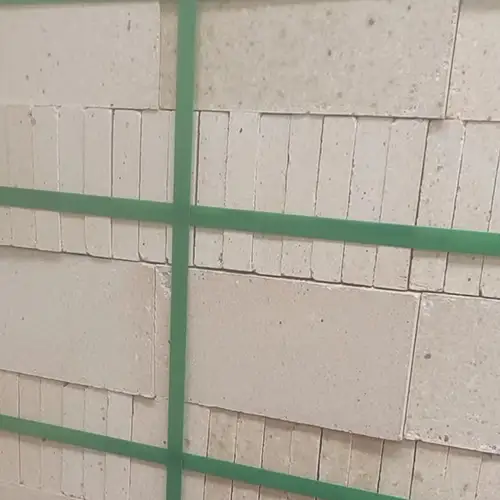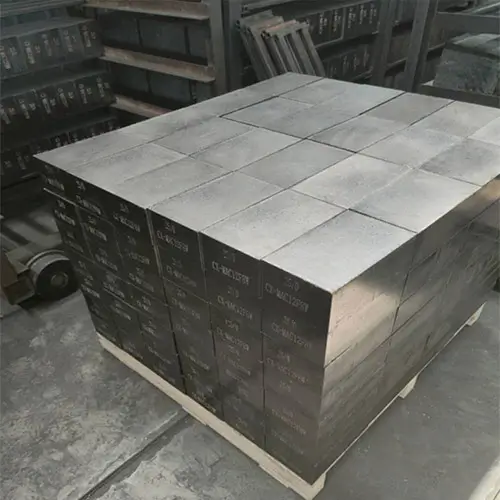Steel ladle (ladle) carries the dual task of carrying steel and refining outside the furnace, with the development of steelmaking technology, China’s ladle refractories have also been well developed. Especially since the 1980s, China’s refractory research institutions, production enterprises and the use of manufacturers, close cooperation, combined with China’s national conditions, and continue to develop a new type of ladle refractory materials, so that China’s ladle refractories with a faster rate of forward development to meet the needs of the rapid development of China’s steelmaking industry.
In the 1950s to 1970s, China’s ladle lining is mainly used in aluminum silicate refractories, including a variety of clay bricks and high alumina bricks. From the 80’s, China has developed a number of series of new ladle refractories such as aluminum-magnesium (carbon), magnesium-carbon and magnesium-calcium (carbon). Among them, aluminum-magnesium (carbon) refractories have many varieties and full specifications, and they are the main refractories for ladle in China.
Aluminum silicate ladle refractory
Clay brick
Clay brick is China’s earliest use of ladle refractory materials, the 20th century, 50 ~ 60 years, China’s ladle refractory materials are mainly used in a variety of clay bricks, due to the use of low-cost, until the 80s there are still a number of steel mills ladle is still used in the use of clay bricks. The physical and chemical indexes of clay bricks for ladle of a steel plant are: Al2O3 44.10%, SiO2 52.10%, Fe2O3 1.72%, apparent porosity 16%~18%, room temperature compressive strength 54.9~96.0MPa. The service life of clay ladle lining bricks varies according to the different conditions of use in each steel plant.
High aluminum brick
With the continuous development of steelmaking technology and steel production and quality continues to improve, clay ladle lining brick due to the use of short life, since the end of the 1960s, some of China’s steel mills ladle began to use a variety of high-alumina lining bricks, so that the life of the ladle has increased dramatically.
Wuhan Iron and Steel flat furnace with 270t ladle from 1968 began to use second-class high alumina bricks, to 1970 the age of the package reached 25.7 times, is the clay lining brick 2.5 times. 1974 the age of the package reached 31.5 times. Wuhan Iron and Steel two steelmaking converter with 70t ladle from 1980 to use Al2O3 content greater than 72% of high alumina bricks, the age of 34 times, up to 50 times.
Baosteel 300t ladle from June 1986, the whole package wall using a refractory materials factory production of first-class high-alumina bricks, the average package age of about 50 times. After the continuous casting machine put into operation, ladle use conditions deteriorate, packet lining service life is shortened. Baosteel and some refractory production enterprise cooperation, developed the use of excellent performance micro-expansion of high alumina bricks, in April 1992 the official use of A factory products, the average service life of 81.5 times, the highest life expectancy of 100 times. The average service life of the products of B factory is 78.6 times, the highest reached 122 times (continuous casting ratio of 55.73%).
TISCO 70t ladle using high aluminum lining brick, service life of 64.3 times.
In short, China’s ladle after the use of high aluminum lining brick, so that the service life of the ladle significantly improved to ensure the smooth progress of steel production, and promote the further development of the steel industry.

High-alumina tamping material
At the end of the 1970s, some steel mills in China use high alumina pounding material for ladle lining, which has achieved good results. High-alumina pounded material is high-quality high alumina bauxite clinker as raw materials (aggregate and fine powder), industrial phosphoric acid as a binding agent, after batching, mixing and formulated into a plasticity of a good non-conformable refractory materials. Adopting the whole pounding technology, it is made into the whole package lining, which obtains a long service life.
Wax tiles
Wax stone brick is a kind of sintered products produced by foliated wax stone as the main raw material.In the early 1970s, a refractory factory in Fujian produced wax stone ladle bricks in Maanshan Iron and Steel, Anshan Iron and Steel, Shanghai Iron and Steel three factories, Sanming Iron and Steel and other iron and steel enterprises in different types of ladle on trial. The results show that the use of wax stone brick performance is better than the use of clay bricks and third-class high alumina bricks. Used on 15t ladle of Masteel, the life span reached 66 times. Wuhan Iron and Steel two steelmaking plant 70t ladle also tried the production of the plant’s SiO2 content of 72% of the wax stone brick, but the effect is not very satisfactory, the service life of only 14 times. Baosteel 300t ladle in September 1985 to 1988 years have been used in Japan imported wax brick, the average life of 38 times [4]. The physical and chemical indexes of the wax stone bricks for ladle produced by a factory are: SiO2 78.95%, Al2O3 18.85%~19.51%, Fe2O3 0.44%~0.52%, apparent porosity 14%~18%, normal temperature compressive strength 32.9~62.9MPa. Due to various reasons, wax stone bricks have not been popularized in China’s steel ladle.
Aluminum-magnesium (carbon) ladle refractories
From the 1980s, China’s steelmaking industry into a rapid development stage, continuous casting and furnace refining and other modern steelmaking technology to promote the application of clean steel production and the increase in the use of ladle refractory materials to make the use of more severe conditions. Steel temperature rise, steel in the ladle to extend the residence time, steel and slag on the ladle refractory materials and slag on the ladle refractory materials of chemical erosion are more serious, the previous ladle refractory materials have been unable to meet the needs of modern steel production. For this reason, China has developed a variety of aluminum and magnesium (carbon) ladle refractories. Aluminum and magnesium (carbon) refractories in the process of use, Al2O3 and MgO at high temperatures to generate magnesium and aluminum spinel reaction of this high-temperature performance of minerals, so that the refractory erosion resistance and anti-spalling performance significantly improved. Therefore, the use of aluminum and magnesium (carbon) ladle refractories can greatly improve the service life of the ladle.
Aluminum and magnesium monolithic pounding material
In the early 1980s, Lonai Institute, Anshan Coke & Patience Institute and Anshan Iron & Steel cooperated and jointly developed the aluminum-magnesium ladle overall pounding material. The pummeling material is a kind of plasticity good indefinite refractory material formulated with special high alumina bauxite clinker as aggregate, special high alumina bauxite clinker powder and sintered magnesium sand powder mix as matrix, and liquid water glass as binding agent. It was used in 200t ladle of Anshan Iron & Steel, and its life expectancy was 5-7 times higher than that of clay bricks, with an average life expectancy of 85.15 times and a maximum of 108 times, and the consumption of refractory material per ton of steel was 2.7 kg. In June 1982, the pounding material passed the appraisal of the former Ministry of Metallurgy. After that, the ladle of many steel mills in the country successively used this aluminum-magnesium ladle overall pounding material, have achieved good results.
Aluminum and magnesium castables
Following the aluminum-magnesium pounding material, China has developed the aluminum-magnesium castable with high-quality high alumina bauxite clinker and sintered magnesium sand as raw materials and liquid water glass as binding agent. The castable “Sixth Five-Year Plan” period first in the small steel ladle on the popularization and application, achieved good results. Such as a steel plant in Hebei 10t and 14t ladle using water glass combined with aluminum and magnesium castables, the average age of a package for 109.7 times, is more than 8 times the clay brick lining. Heilongjiang a steel plant 15t and 13t ladle, the use of aluminum and magnesium castables, a package age of 53 times, while the clay lining brick package age is only 6 to 10 times.
The whole ladle casting lining technology was listed as the former Ministry of Metallurgy key new technology promotion projects in the country. By the third quarter of 1987, China’s 30t converter with small and medium-sized ladle (45t capacity), most of the whole cast lining. Integral casting lining life of 40 to 60 times, some small ladle up to 90 times [13]. Refractory consumption and lining costs decreased significantly, and achieved significant economic benefits. A steel mill ladle water glass combined with aluminum and magnesium castables physical and chemical indicators for Al2O3 75.20%, MgO 9.47%, SiO2 10.25%, bulk density (110 ℃ × 24h) 2.67 ~ 2.73g./cm3, room temperature flexural strength (110 ℃ × 24h) 14.9MPa.
Aluminum and magnesium unburnable bricks
In addition to aluminum and magnesium pounding material, aluminum and magnesium castable material, our country also developed a water-glass combination of aluminum and magnesium non-burning bricks, in the ladle on the use of life than the traditional alumino-silicate ladle bricks long. Ben steel 160t ladle using aluminum and magnesium unburnable brick, the average life of 40.56 times, than the use of third-class high alumina brick (life of 18.5 times) to improve more than 1 times. Tianjin three steel mill 20t ladle using aluminum and magnesium unburnable brick average life 38.8 times, up to 55 times, is the clay lining brick life (9 times) more than 4 times.
A factory production of water glass combined with aluminum and magnesium unburnable brick physical and chemical indicators are: Al2O3 68.46% ~ 74.07%, MgO 7.65% ~ 12.32%, SiO2 9.02% ~ 13.37%, Fe2O3 1.12% ~ 1.83%, bulk density of 2.48 ~ 2.86g/cm3, the apparent porosity of 16% ~ 23%, the room temperature compressive strength of 55.6 ~ 123MPa. 55.6~123MPa.
Magnesium-aluminum spinel castables
In the early 1990s, with the bauxite-based synthetic magnesium-aluminum spinel put into industrial production, a number of refractory research institutes and production enterprises in China have developed a variety of different performance of bauxite-based magnesium-aluminum spinel castables for ladle. Because of this kind of castables with a certain proportion of pre-synthesized magnesium and aluminum spinel, so that the anti-erosion performance and anti-flaking performance of the castables is greatly improved, and its performance is better than the water-glass combination of aluminum and magnesium castables. It has been used in various types of ladle and achieved good results.
Luonaiyuan and Henan a refractory factory jointly developed bauxite-based aluminum-magnesium spinel castables by TISCO 70t (DH vacuum lance blowing argon) ladle, HISCO 30t continuous casting ladle (continuous casting ratio of not less than 94%) trial, the average life of up to 71 and 114 times, respectively, than the water-glass bonded aluminum-magnesium castables to improve the respectively 1 to 3 times. Hangzhou, a steel plant 25t continuous casting (continuous casting ratio of more than 70%) ladle using magnesium-aluminum spinel castables, the average package age of 77 times, than the water glass combined with aluminum-magnesium castables to improve 1.2 times. Jiangxi New Steel a steelmaking plant 28t ladle using magnesium and aluminum spinel castables, the average life of 79 times, than water glass combined with aluminum and magnesium castables increased by 1.6 times.
Bauxite-based magnesium-aluminum spinel castables are made of high-quality high-alumina bauxite clinker as aggregate, high-quality high-alumina bauxite clinker powder, synthetic magnesium-aluminum spinel powder and sintered magnesium sand powder as matrix, and the binding agents are: polyphosphate, SiO2 micropowder, Al2O3 micropowder, and pure calcium aluminate cement. The physical and chemical indexes of bauxite-based magnesium-aluminum spinel castables produced by a factory are as follows: Al2O3 68.84%, MgO 14.63%, SiO2 11.27%, Fe2O3 1.74%, bulk density (110℃×24h) 2.73g/cm3, room temperature compressive strength of 42.88MPa, room temperature flexural strength of 55.1MPa.
Aluminum-magnesium-carbon bricks
In the 1990s, is the rapid development of China’s continuous casting technology period, high-efficiency continuous casting technology has become the center of gravity of its development. In order to improve the service life of continuous casting ladle, to adapt to the needs of the development of high-efficiency continuous casting technology, our country has developed a ladle with aluminum magnesium carbon bricks for various types of continuous casting ladle, so that the service life of the ladle greatly improved.
Luonai hospital, baosteel and jiaozuo a refractory materials factory co-developed aluminum magnesium carbon ladle bricks in baosteel 300t continuous casting ladle on the use of ladle age from the use of first-class high alumina bricks more than 20 times, increased to more than 80 times, the highest reached 126 times. Anshan Iron and Steel three steelmaking 200t all continuous casting and furnace refining ladle, the use of aluminum-magnesium carbon bricks, the average life expectancy of 64 times, up to 73 times. 1993 ladle with high-quality aluminum-magnesium carbon bricks with the popularization of the use of the full-scale in our country, many of the country’s steel mills, according to the actual situation of the enterprise, one after another, the use of aluminum-magnesium carbon ladle lining bricks, so that the ladle’s life expectancy significantly improved, such as Pangangang 160t ladle using aluminum-magnesium carbon lining bricks, the average life expectancy increased to 90 times, the average life expectancy of the ladle lining bricks. After using aluminum-magnesium-carbon lining bricks, the average life expectancy has increased to 90 times, with a maximum of 115 times.
Aluminum-magnesium-carbon bricks are made of special high-alumina bauxite clinker, electrofused magnesium sand or sintered magnesium sand and graphite as raw materials, and liquid phenolic resin as binding agent.

Magnesia-aluminum spinel carbon bricks
In the development of aluminum-magnesium carbon bricks on the basis of China has developed a steel ladle with magnesium-aluminum spinel carbon bricks. Aluminum-magnesium spinel carbon brick is added to a certain proportion of pre-synthesized magnesium-aluminum spinel in the brick material, and its performance is better than that of the same grade of aluminum-magnesium carbon brick.
Jiaozuo a refractory factory and Baosteel cooperation in the development of magnesium and aluminum spinel carbon brick in Baosteel 300t continuous casting ladle on the use of the average service life of 105 times, up to 200 times. The magnesium-aluminum spinel carbon bricks developed by the General Research Institute of Architecture are used in Anshan Iron and Steel’s 200t continuous casting ladle with out-of-hearth refining, with an average service life of 73.3 times and a maximum of 82 times. Shougang and xinxiang a refractory materials factory cooperation development of aluminum magnesium spinel carbon brick in shougang two steel 90t ladle on the use of life from the original use of aluminum magnesium carbon brick 20 times to 40 times, up to 51 times.
The development and use of aluminum-magnesium spinel carbon brick, so that the service life of our continuous casting ladle has been further improved.
High-grade aluminum and magnesium unburnable bricks
Carbon-containing ladle lining brick in the use of the process will cause the molten steel carbonization, smelting clean steel, low carbon steel and ultra-low carbon steel is very unfavorable. In order to meet the needs of clean steel, low-carbon steel and ultra-low-carbon steel smelting, the development of high-grade aluminum and magnesium non-burning bricks (carbonless non-burning bricks). High-grade aluminum and magnesium non-fired brick and the early 1980s development of water-glass combination of aluminum and magnesium non-fired brick compared to a qualitative leap. In addition to the use of high-purity raw materials (corundum, high-purity fused magnesium sand and high-purity aluminum and magnesium spinel, etc.), the combination of agents are also used in high-performance composite binding agent.
High-grade aluminum and magnesium non-burning bricks in the ladle on the use of good results, the service life to reach or even exceed the carbon ladle lining bricks, while reducing the carbon increase in molten steel. Such as Henan a refractory materials company developed aluminum and magnesium not burning brick, in a steel plant 100t ladle and LF refining ladle on the use of life is aluminum and magnesium carbon brick 1.5 times.
Anshan steel 200t ladle using aluminum-magnesium non-burning brick a package age of more than 110 times, up to 128 times. 170t continuous casting ladle service life of 119 times, more than the aluminum-magnesium carbon brick. Baosteel 300t continuous casting ladle from June 1998 to stop using aluminum-magnesium carbon bricks, began to use high-grade aluminum-magnesium unburnable bricks.
High-grade aluminum and magnesium (spinel) castables
In the mid-1990s, China developed high-grade aluminum and magnesium castables for large and medium-sized ladles. The raw materials used in high-grade aluminum and magnesium (spinel) castables are corundum (fused corundum, sintered corundum, etc.), high-purity fused magnesium sand, high-purity aluminum and magnesium spinel (fused and sintered), etc. The binding agent is pure calcium aluminate cement, Al2O3 micropowder, high-purity SiO2 micropowder and so on. The binding agent has pure calcium aluminate cement, Al2O3 micropowder, high purity SiO2 micropowder, etc.
